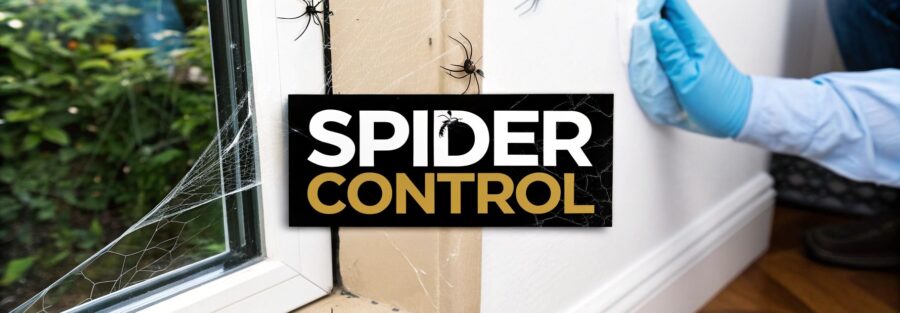It’s one thing to see the odd spider scurrying for cover in autumn, but it's another thing entirely to deal with what we in the pest control world call a true spider infestation UK homeowners dread.
This isn’t about the occasional visitor; it’s about a resident population setting up a permanent base in your home. Recognising the signs early is your first and most important step to getting things back under control.
Is It a Real Spider Infestation?
As the weather cools, it's completely normal to see more spiders indoors. It's easy to think you've got a major problem on your hands, but not every uptick in spider sightings means you’re facing a full-blown infestation.
You need to know the difference between seasonal guests and a persistent problem before you act. A genuine infestation leaves behind some very specific clues that go well beyond just spotting a few eight-legged lodgers.
Frequent and Widespread Sightings
Seeing a big house spider in the bath is practically a British rite of passage in late summer. An infestation, though, is different. It means you’re spotting spiders consistently and all over the house—not just in the dusty corners of the garage.
Are they showing up in the living room, kitchen, and even bedrooms? When you see them this often and in so many different places, it’s a strong hint that they're actively living and breeding within your home's structure, not just passing through.
An Abundance of Webs and Egg Sacs
A couple of delicate webs in a window frame are to be expected. But discovering a high density of webs, especially those messy, tangled ones, tucked into corners, under furniture, or along ceilings is a major red flag.
The most definitive sign of an established population, however, is finding multiple spider egg sacs. These are small, silk-wrapped balls, often hidden away in dark, undisturbed spots like the back of a wardrobe or under a shelf. Finding these means a new generation is just waiting to hatch.
A single spider egg sac can contain hundreds of eggs. Finding several of them is a clear signal that the spider population in your home is actively growing and needs attention.
To give you a better idea of what to look for, here's a quick guide to some of the common spiders you might find setting up shop in UK homes.
UK Spider Identification Quick Guide
| Spider Species | Appearance | Common Locations | Infestation Risk |
|---|---|---|---|
| House Spider | Large, brown, with hairy legs. Can grow up to 12cm leg span. | Dark corners, sheds, attics, and often in baths. | Low. More of a nuisance than an infestation threat. |
| Money Spider | Very small (under 5mm), dark, and often seen hanging from silk threads. | Ceilings, walls, and plants. Commonly float in on the wind. | Low. They are solitary and not considered an infestation pest. |
| False Widow Spider | Shiny, black/brown body with cream-coloured markings on the abdomen. | Sheds, garages, window frames, and conservatories. | Moderate. Can form localised populations if conditions are right. |
| Cellar Spider | Very long, thin legs with a small, peanut-shaped body. | Cellars, garages, and undisturbed corners. Creates tangled, messy webs. | Moderate. Can produce many offspring and create extensive webbing. |
Knowing which spiders are harmless visitors and which could indicate a bigger issue is key. Monitoring spider populations is a serious undertaking. The British Arachnological Society's Spider Recording Scheme, for instance, has collected data since 1987, tracking how species like the false widow have spread, particularly in southern England.
If you're concerned about a potential UK spider infestation, our detailed guide offers even more clarity and practical next steps.
Identifying Your Unwanted House Guests
Before you can tackle a spider problem, you need to know exactly what you’re up against. Think of it as reconnaissance. Not all spiders are created equal; their habits, looks, and reasons for shacking up in your home can be wildly different. Figuring this out is the first step in deciding whether you've got a harmless wanderer or the beginnings of a full-blown spider infestation.

Honestly, many of the spiders you’ll find in the UK are doing you a favour, acting as a free pest control service for flies and other insects. But some species are far more likely to set up large, noticeable colonies indoors. Let's get to know the usual suspects.
The Most Common Indoor Spiders
Giant House Spider (Eratigena atrica)
This is the one that sends people running. With a leg span that can reach up to 12cm, its size and surprising speed are definitely intimidating. They’re usually brown with some faint markings. The good news? Despite their scary appearance, they're harmless to us. You'll typically spot them in late summer and autumn when they’re on the hunt for a mate – often in dark corners, behind the sofa, or famously, stuck in the bathtub.
Cellar Spider (Pholcus phalangioides)
You probably know this one as the "daddy long-legs spider." It’s unmistakable with its tiny body and incredibly long, spindly legs. They spin messy, chaotic webs in quiet corners of cellars, garages, and sheds. While one or two aren't a big deal, they can reproduce quickly, and soon you'll have unsightly webbing taking over an entire room.
False Widow Spider (Steatoda nobilis)
This spider has earned quite a reputation over the years. You can spot it by its shiny, bulbous abdomen, which is usually black or brown with distinct cream-coloured markings. False Widows love warm, sheltered spots, so you’ll often find them in window frames, conservatories, and sheds. Their bite is rare and typically no worse than a wasp sting, but a large population is certainly a cause for concern, making proper identification key.
A single spider is usually just passing through and no real threat. But species like the False Widow and Cellar Spider are known for setting up breeding populations indoors if the conditions are right. That's when a few visitors can turn into a persistent problem.
Where to Look for Spider Hiding Spots
Spiders are creatures of habit. They seek out quiet, dark, and sheltered spots where they won't be disturbed and where their next meal might wander by. Knowing where to look is half the battle.
When you're doing a sweep of your property, focus on these hotspots:
- Attics and Lofts: This is prime real estate for spiders. It’s dark, cluttered, and undisturbed.
- Basements and Cellars: Damp, dark, and full of corners – a perfect home for Cellar Spiders.
- Garages and Sheds: These spaces are rarely visited and have plenty of entry points and hiding spots among tools and boxes.
- Behind Furniture and Appliances: Those dark gaps behind the wardrobe, sofa, and fridge are ideal retreats.
- In Wall Voids and Eaves: Any cracks or gaps in your home's structure are a welcome invitation for a secure, hidden nest.
By methodically checking these areas for live spiders, webs, and egg sacs, you'll get a clear picture of who's moved in and how settled they are. This is the intel you need to move on to control and prevention.
Safe and Sensible Spider Control Methods
Right, so you've found spiders. The first instinct for many is to grab the nearest can of powerful chemical spray and go to war. But hold on. A more thoughtful, eco-friendly approach is not only safer for your family and pets but often far more effective in the long run.
The goal isn’t just to get rid of the spiders you can see. It's about making your home a place they want to avoid altogether.
This all starts with disrupting their environment. Spiders love quiet, cluttered spots where they can spin a web and lay their eggs undisturbed. A proper deep clean is your first, and best, line of defence.
Start with Habitat Disruption
I'm not talking about a quick flick with a duster; this needs to be a bit more methodical. Zero in on the classic spider hotspots: attics, cellars, garages, and behind hefty bits of furniture. Your best friends here are a vacuum cleaner with a long hose attachment and a decent duster.
Go through and methodically vacuum up every web, spider, and any of those little silk-wrapped egg sacs you find tucked into corners. Getting rid of the egg sacs is absolutely crucial. A single one can hold hundreds of spiderlings, so this one action can stop a population explosion before it even starts.
Tackling the source is always more effective than just dealing with the symptoms. When you remove webs and egg sacs, you're not just cleaning – you're actively breaking the spider lifecycle and making the area less inviting for them to return.
Decluttering is the other half of this battle. Piles of old newspapers, cardboard boxes, and forgotten storage create five-star hotels for spiders. By organising these areas and, ideally, storing things in sealed plastic tubs, you instantly remove countless hiding places.
The scale of a spider infestation UK homeowners might face can differ depending on where you live. This graphic gives you an idea of the reported annual rates across a few key areas.

As you can see, built-up areas like London often report higher numbers, which is likely down to housing density and other environmental factors.
Embrace Natural Spider Deterrents
Once you’ve cleaned and decluttered, the next step is to put down some deterrents to keep them from coming back. You’d be surprised how well natural options work. They rely on scents that we might find pleasant, but spiders find completely overwhelming and repulsive.
These methods are safe, simple, and easy to work into your regular cleaning routine.
- Peppermint Oil: This is the classic natural spider repellent for a reason. Just mix about 15-20 drops of good quality peppermint essential oil with water in a spray bottle. Give it a light mist around window frames, doorways, and any cracks where you think spiders might be getting in.
- Vinegar Solution: A simple mix of equal parts white vinegar and water is a great contact repellent. Spiders hate its acidic nature, and the strong smell puts them off setting up camp in treated areas.
- Citrus Peels: Spiders really aren't fans of citrus smells. Leaving fresh lemon or orange peels on windowsills, in bookcases, or under sinks can be enough to encourage them to move on.
Exploring natural spider repellents for home can offer more gentle yet effective ideas if you're keen to avoid chemicals. These solutions work by creating an invisible barrier that makes your home far less appealing.
If you want to learn more about the broader signs and solutions for a confirmed infestation of spiders, our detailed guide offers plenty more insight. Combining these humane methods with physical removal creates a powerful and sustainable strategy for keeping your home spider-free.
Natural vs Chemical Spider Control
When deciding on a plan of attack, it helps to weigh up your options. Both natural and chemical methods have their place, but they serve different purposes. Here's a quick comparison to help you choose the right approach for your situation.
| Control Method | Effectiveness | Safety (Pets/Children) | Best For |
|---|---|---|---|
| Natural Deterrents | Moderate, requires consistent reapplication. Best for low-level issues and prevention. | High. Generally safe when used as directed. | Creating an unwelcoming environment, regular maintenance, and homes with sensitive occupants. |
| DIY Chemical Sprays | Moderate to High. Effective on contact but often lacks residual effect. | Low to Moderate. Requires careful handling and ventilation. Can be toxic if ingested. | Dealing with visible spiders quickly in specific, contained areas. |
| Professional Pest Control | Very High. Uses targeted, professional-grade products with lasting effects. | High. Professionals use products safely and advise on any necessary precautions. | Serious infestations, recurring problems, or for total peace of mind. |
Ultimately, the best method depends on the scale of your problem. For a few stray spiders, natural deterrents are a fantastic, safe choice. But for a persistent infestation that keeps coming back, calling in the professionals is often the most effective and safest route in the long run.
How to Spider-Proof Your Home for Good
Getting spiders out of your house is a great start, but the real win is keeping them out for the long haul. True prevention is all about making your home a lot less welcoming to them. You need to think like a spider and block off all the easy ways they sneak inside.
Taking preventative steps is your best defence against the seasonal spider infestation UK homeowners often dread. It’s about being proactive, which involves a bit of detective work and some simple but effective home maintenance.
Seal Every Entry Point
Spiders are masters of squeezing through the tiniest of gaps. To them, a small crack in the foundation or a gap around a utility pipe is a wide-open door. Your first job is to give your home's exterior a thorough once-over.
Look for and seal up any potential entry points you can find. Pay special attention to:
- Gaps around window and door frames.
- Cracks in the brickwork or foundation.
- Holes where utility lines, pipes, or cables enter the house.
- Any damaged or torn window and door screens.
A good quality sealant or caulk works perfectly for small cracks. For bigger gaps, expanding foam is a solid choice, and I often recommend wire wool for plugging holes around pipes – rodents hate it too, which is a nice bonus.
Manage Your Outdoor Environment
Your garden can either invite spiders in or send them packing. An overgrown garden is a five-star hotel for spiders, offering endless hiding spots and a buffet of insects to eat, drawing them ever closer to your house.
A few simple landscaping tweaks can make a massive difference. Start by trimming back any bushes, trees, or ivy that are touching the house itself, creating a clear gap. It’s also wise to keep woodpiles, compost bins, and general garden debris as far away from your foundation as possible.
Here's another smart move: rethink your outdoor lighting. Standard white bulbs are magnets for moths, flies, and other insects—a spider's dream meal. Switching to yellow or sodium vapour bulbs can drastically cut down on the number of insects buzzing around your home, making it a much less attractive hunting ground for spiders.
It's a common misconception that spider numbers are booming. Interestingly, recent ecological studies show an overall decline in UK spider populations, which may lead to occasional spikes in indoor sightings as their outdoor habitats are disrupted. You can learn more about these spider population findings.
Maintain a Clean and Tidy Interior
Spiders absolutely love clutter. Piles of newspapers, old boxes, and general untidiness create the perfect dark, undisturbed corners for them to spin webs and lay their eggs. Regular, thorough cleaning is genuinely one of the most powerful prevention tools you have.
Keeping your home meticulously clean robs spiders of their favourite hiding spots. For a systematic approach, following a comprehensive home cleaning checklist can make sure you don't miss any of those spider-friendly nooks and crannies.
Focus on vacuuming regularly, getting right into corners, under furniture, and into little-used rooms like attics and basements. Don't forget to dust and clean behind big appliances, either.
By removing potential hiding spots and any existing webs or egg sacs, you're sending a very clear message: your home is not open for business. This consistent effort is what really makes the difference.
Alright, let’s be honest. DIY methods are great for tackling the odd spider here and there, but sometimes you’re just plain outgunned. Knowing when to wave the white flag and call in a professional is the key to winning the war against a persistent spider infestation UK homeowners often dread.

It’s a classic story: despite your best efforts with the hoover and all the natural deterrents, the spiders just keep coming back. That’s usually the biggest clue that you’re dealing with something more established than a few lone wanderers. Chances are, you’ve got a breeding population tucked away in wall voids, the loft, or other spots you can’t easily reach.
Signs You Need an Expert
If you’re seeing a large and growing number of spiders, especially if you suspect they’re False Widows, it’s time to get some professional advice. These spiders are particularly good at setting up shop in sheltered areas, meaning a few sightings can quickly snowball into a much bigger problem that needs a proper treatment plan.
Another critical reason to call in the pros is simply for your family’s wellbeing. A severe case of arachnophobia is no joke, and living with a constant stream of eight-legged intruders can cause real distress. In these situations, getting professional help is as much about restoring your peace of mind as it is about getting rid of the spiders.
When your own efforts don't stop the spiders from returning, it's a sure sign of a deeper issue you can't see. A pro is trained to find the root cause—like hidden entry points or established nests—to deliver a solution that actually lasts.
What to Expect From a UK Pest Control Service
Hiring a professional isn't just about spraying some chemicals and calling it a day; it’s a methodical process. A good technician will always start with a thorough inspection to figure out what species you’re dealing with, locate their nesting sites, and get a clear picture of how bad the infestation really is.
From there, they’ll recommend a treatment plan, walking you through the products they’ll use and any safety precautions needed for your family and pets. Communication is everything, so never hesitate to ask questions.
A huge part of the service is figuring out how the spiders are getting inside in the first place. A proper pest control expert will give you practical advice on proofing your home to stop them from coming back. This might mean sealing up cracks, making recommendations about your outdoor lighting, or spotting other contributing factors. The goal should always be long-term prevention, not just a quick fix.
Data from the pest control industry shows that demand can vary massively by area. For instance, a 2016 report on London found Lambeth accounted for 6.26% of all pest treatments, while boroughs like Greenwich saw far lower numbers. This just goes to show how different infestation levels can be from one region to another. Understanding the full scope of available pest control services will help you pick the right approach for your home.
Common Questions About UK Spiders
Seeing a few too many eight-legged visitors scurrying around can bring up a lot of questions. It’s easy for myths and anxieties to take over, especially when you feel outnumbered in your own home. Let’s clear the air and tackle some of the most common queries we get from homeowners across the UK.

Why Are There So Many Spiders in My House This Year?
If it feels like your home has suddenly become a spider hotspot, you’re not imagining things. It often boils down to two key factors: the weather and the availability of their food.
A mild, damp spring followed by a warm summer creates a boom in flies, gnats, and other insects. For spiders, this is an all-you-can-eat buffet, allowing them to thrive and reproduce in huge numbers. Come autumn, this bumper generation of spiders starts looking for a warm, dry place to shelter and find a mate – and your house is the perfect destination.
It's also worth considering your local environment. Nearby building work, a neighbour clearing out their garden, or even tidying up a disused shed can disturb established spider habitats, sending them searching for a new, safer home. Unfortunately, that could be yours.
What Time of Year Is Spider Season in the UK?
While you can spot spiders in UK homes at any time, what most people call "spider season" really kicks off from late summer through autumn. It usually hits its peak around September and October.
This isn't an invasion in the true sense. It’s the time of year when many male spiders, like the big Giant House Spiders, have reached maturity. They abandon their webs and go on the hunt for a female, a journey that often leads them right into our homes. That mad dash across the living room carpet? He's on a mission.
The feeling of a "spider season" is mostly down to the sudden visibility of large male spiders on the move. The actual population has likely been around all year, but their behaviour changes dramatically during this mating period.
Are UK House Spiders Actually Dangerous?
This is the big one, and the answer is a resounding no. The overwhelming majority of the 650+ spider species we have in the UK are completely harmless to people. In most cases, their fangs are simply too small or weak to even break human skin.
The one species that gets a lot of media hype is the False Widow spider. While it can bite, it only ever does so as a last resort if it gets trapped or squashed against your skin. The bite itself is often compared to a bee or wasp sting, leading to some localised pain, redness, and swelling which usually fades within a day or so.
Serious allergic reactions are incredibly rare. For almost everyone, a spider in the house is just a bit of a nuisance, not a genuine danger.
If you're feeling overwhelmed by a spider problem or just need some professional advice, don't hesitate to get in touch. Pest Predators Limited offers effective, evidence-based solutions to give you back your peace of mind. Learn more about our effective pest control services.



